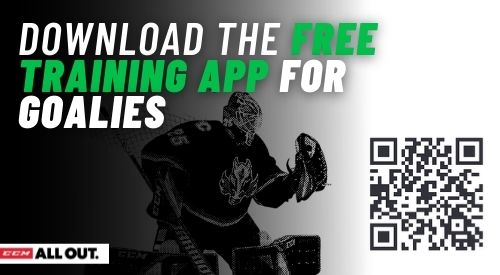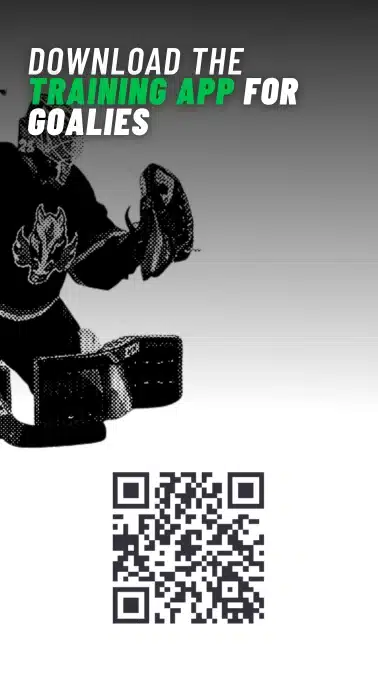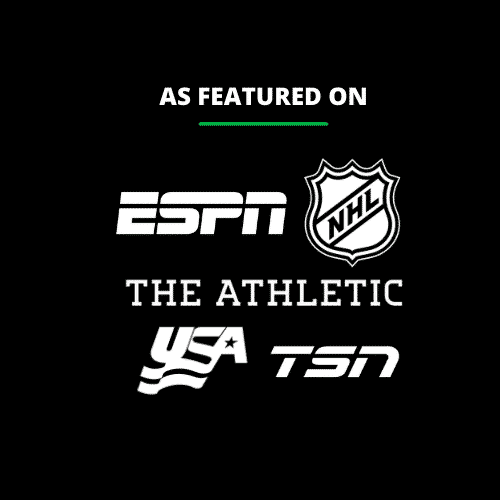In our guide on “how to become a better goalie“, we talk about catching pucks as one of the few things a goalie can and should have complete control over. While it’s not the single most important, learning how to develop your glove hand is without question one of the most important things a goalie can do.
It is nearly impossible to become a better goalie without developing improving your glove hand. Puck watching, also referred to as puck tracking, and catching pucks are two abilities that every goalie playing in the NHL is better at than nearly every goalie in the world. There are many reasons why this is a significant advantage, which we’ll dive into below.
Put a goalie coach in your pocket with the Goalie Coaches training app, built specifically for hockey goalies. The Goalie Coaches app has been used at every level of play, up to the NHL. Unlock hundreds of drills, game specific scenarios, and more inside the free app, today.
3 Ways Goalies Can Improve Their Glove Saves Immediately
Getting better at your glove saves will not happen unless you understand just why this piece of equipment is arguably the most important piece. The glove gives the goalie total control over the playing surface. If you can catch more pucks and contain them, you can choose to stop play when you please. This gives your team the advantage of changing lines and a clean opportunity to win the puck back after a face-off.
There is no other piece of equipment a goalie wears where it’s sole purpose is to keep the puck in a locked area. Chest protectors are the closest piece of equipment designed to not give out rebounds, but they cannot catch pucks like a glove will. The goalies stick, pads, and blocker are all designed to push pucks out of the immediate danger area as quickly as possible. While this is good, it also increases the opportunity for a negative situation to occur, as a rebound could not go where you want. With your glove, should you have the ability to catch well, you can stop play immediately.
Elite goalies possess a better glove hand for 3 main reasons.
- They are better at simply watching the puck all the way into the body
- They catch pucks in front of their body.
- They have a much larger area in which they can and will catch pucks.
Let’s start with the first and most important thing you can do to improve your glove hand.
Watch Pucks All The Way Into Your Glove
Most goalies struggling to make glove saves do not have a puck catching problem, they have a puck watching problem. The single most important thing to making any save is proper vision of the puck. If you’re struggling with your glove saves, start by focusing on watching the puck the entire way into the glove. While this may seem obvious, it’s the number one thing I see young goalies struggling with. If you’re a catcher in baseball, you do not close your eyes or look the opposite direction while catching a pitch.
As a goalie, why would it be any different? Take a look at the photo below. Carter Hart, an elite puck catching goalie, demonstrates the puck watching point exactly. In this example, Hart not only has his eyes connected to the puck, he is catching the puck in front of his body. Catching pucks in front of your body is our next point, but first, let’s take a look at what is called “The Connected Eyes”.
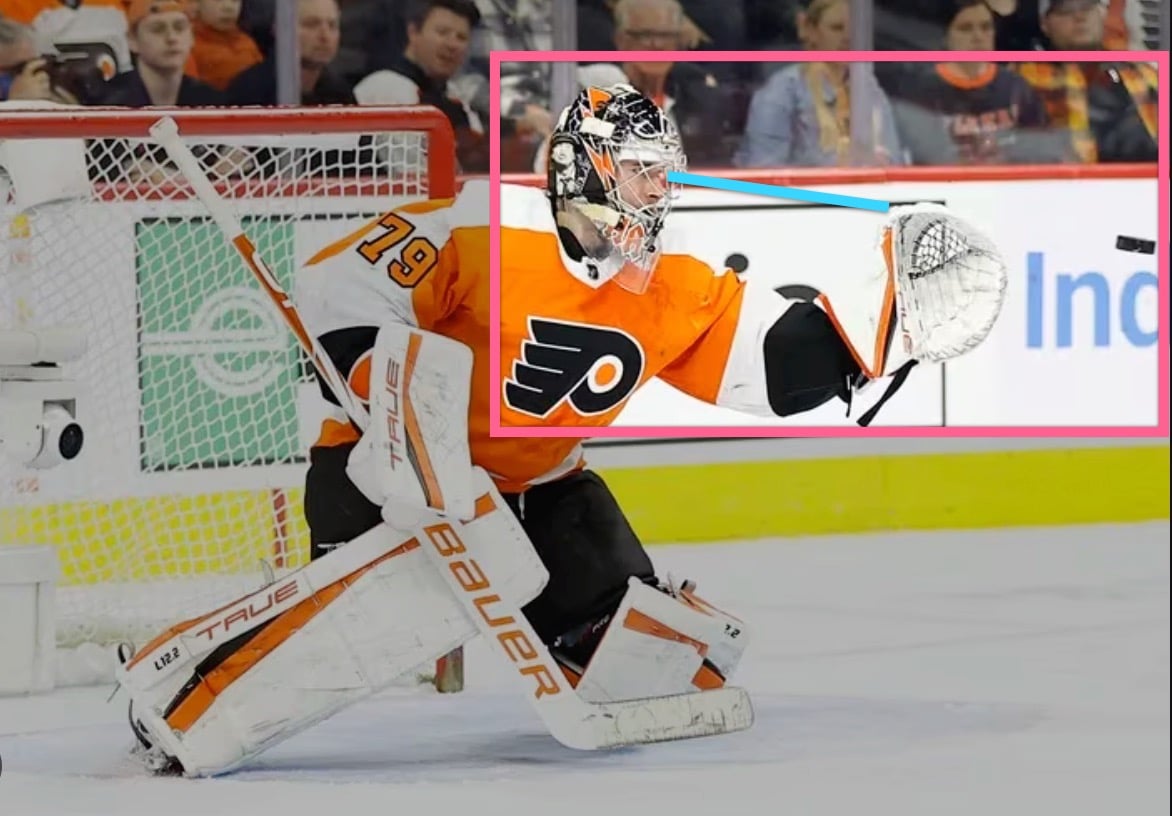
Connected Eyes: why your glove, your eyes, and the puck forming a line makes it easier for you to make more glove saves.
In a blown up diagram of the image above, we show what it means to have your eyes connected with the puck and your glove placed directly in the middle of that line.
While this is not a requirement to make more glove saves, watching the puck all the way into your glove will drastically improve your ability to place pucks in the pocket of your glove, reducing the chances they bounce out for a bad rebound.
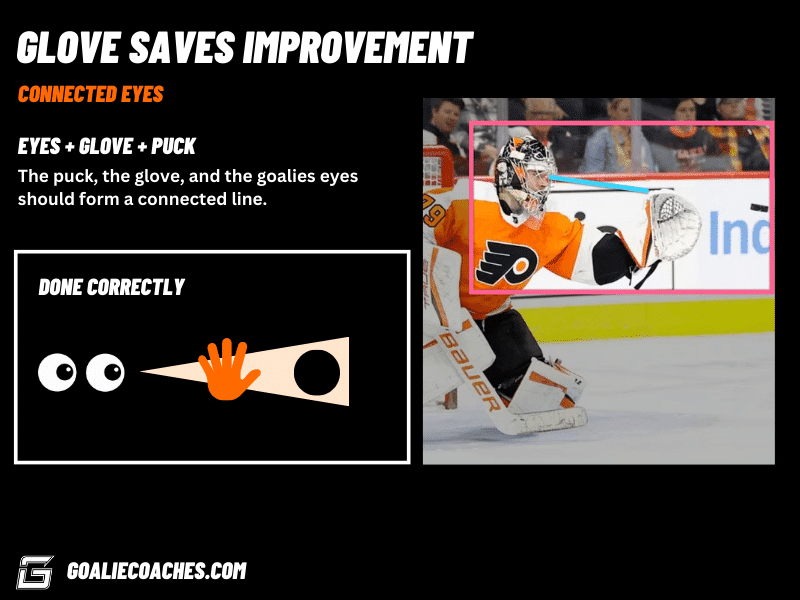
Another example of a goalie making a proper glove save with eyes following the puck all the way into the body.
In the photo example below, Seattle Kraken goalie is making a glove save. Notice how Daccord’s eyes are locked onto the puck, which was presumably shot at a high rate of speed (it is the NHL, after all). Daccord watched the puck from the blade of the opposing players stick, all the way into his glove. This is what is often referred to as an elite “puck tracking” ability.
Daccord is able to follow the progress of the puck from the shot, to his goalie glove. Using this photo as a continued example of proper goaltending technique, notice the position of Daccord’s stick. While he is making a proper glove save, his stick is also in a position to make a stick save, without thinking. Goalies who demonstrate high levels of technique make their lives easier across the board by doing this without thinking.
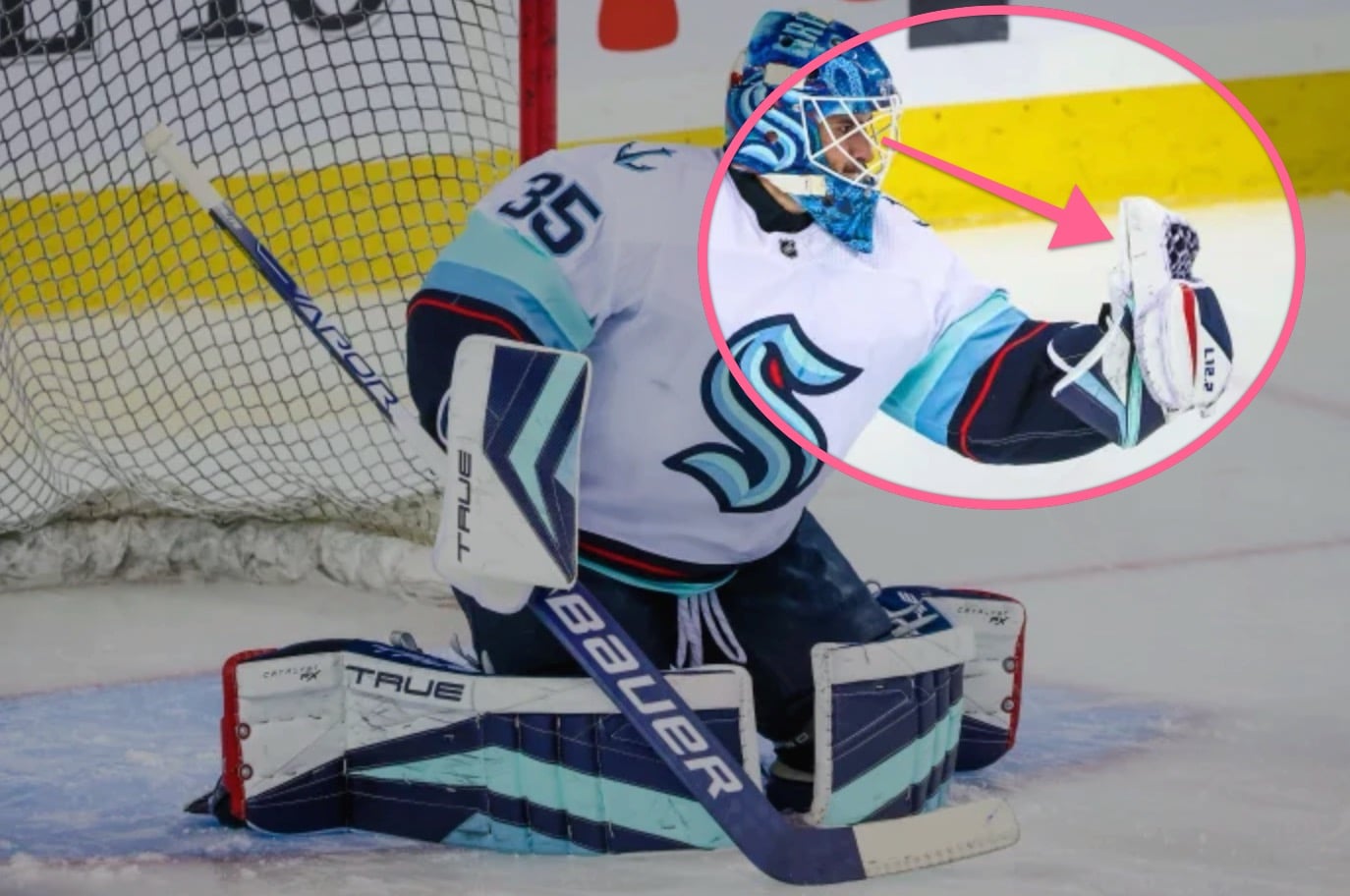
2 Drills To Improve Your Glove Hand for Goalies
Any opportunity you have to catch pucks is a drill that will improve your glove hand, however, there are two that I tell every goalie to do every day. There are a million glove improvement drills out there, these are two of the easiest for any goalie at any level. I can assure you, if you take the time to do drill #1 daily and drill #2 whenever you get the opportunity, you will get a better glove hand.
As with any drill, remember why you’re doing the specific drill. Focus on the single element you are working on, forcing yourself to be present and improving that single element. In both of these drills, we are focusing on simply watching the puck all the way to your glove.
Drill 1: the racquet ball
Have a racquet ball, or a tennis ball? Throw it at the wall 200 times and each time, practice watching the ball from the moment it leaves the wall, into your bare hand. It’s important that you start with your bare hand first, as this will force you to watch the ball into a smaller area. Always start this drill with your bare hand before progressing to your glove. In 10 minutes, you can easily perform this drill 200 times. Do it daily, you will get a better glove hand (almost overnight, for many).
Drill 2: the post practice puck pick-up
After your teams practice is over, rather than simply picking the pucks up and placing them into the bucket, have your teammates stand 10-15 feet away, shooting them one by one into your glove. Of course, when you make the save you’ll place the puck into the bucket. Take the time to watch each shot from it’s release up to the moment it enters your glove. To force that you’re doing this, hold the glove in front of you for 1-2 seconds after making the save.
Does my glove need to be broken in to make glove saves?
Youth goalies struggle with this question mightily. A well broken in goalie glove is much easier to trap pucks in, but it is not necessary to start working on overall puck tracking ability. If you’re struggling to break in your goalie glove, take a look at the linked article.
Learn To Catch Pucks In Front Of Your Body
Alright, we’ve covered “Connecting The Line”. Let’s talk about catching pucks in front of your body.
One thing you can do to improve your glove as a goalie, thus improving your puck catching ability, is to learn to catch pucks in front of your body. This improves dramatically when you get better at watching pucks all the way in to your glove. Sticking with the Carter Hart example, let’s take a look at the right and wrong ways to place your glove for a proper glove save.
Most of the younger goalies we work with that are struggling to make glove saves are also struggling with where they place their glove. The glove hand should be out in front of the goalies body. This is demonstrated on the right side of the image below (blue triangle). In this photo, Hart is preparing to make a save, with his glove hand properly in front of his body. It is not at his side, as shown in the top square below.
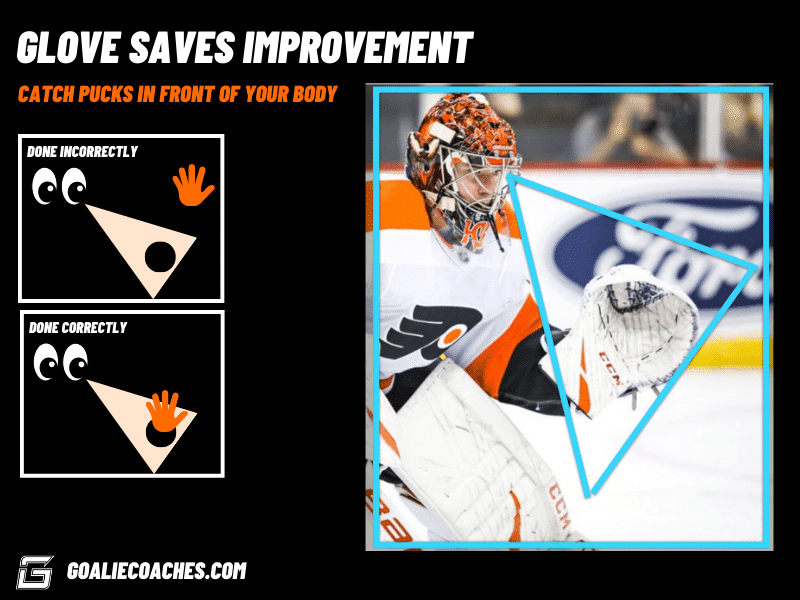
The reason goalies should hold their glove in front of their body is that when the shot happens, the eyes of the goaltender are already connecting the glove and the puck. If the glove is held to the side of the goalies body, the most important component of this is missing.
Another mistake goalies make when preparing to make a glove save is holding their glove higher than necessary. All goalies should be well versed on the subject of box control, or what the puck sees from ice level. In the image below, we’ve outlined this in blue. These are the only places the puck can travel to still enter the net under the crossbar. Holding your glove hand any higher than the blue line is a mistake and you’re setting yourself up for an increased possibility of failure.

Increase Your Puck Catching Area
While this is listed as the 3rd item in this list, it’s arguably the most important. The reason it’s not listed as number one, is without watching pucks to your glove and catching pucks in front of your body, it cannot happen.
In the image below, we outline the catching area of most goalies as compared to the catching area of elite goalies. Most goalies are capable of catching pucks within a general area of their already positioned glove hand. Elite goalies on the other hand, possess the ability to catch gloves in a much wider area.

Improving your puck catching area starts with improving these two zones.
- Middle of body shots
- Low pad shots
Zone #1 is Middle of Body Shots
The chest protector can be a dangerous area if you are not adept at trapping pucks, preventing rebounds. If given the opportunity, a proper glove save here can immediately mitigate any risk of a rebound.
Zone #2 is Low Pad Shots
This is something that NHL goalies do without thinking, where many younger lesser experienced goalies rely on their pads. In the video below, we show New Jersey Devils goalie Akira Schmid making what looks to be a routine save with his glove hand.
The difference in this versus lesser experienced goalies is that many of them would use their stick or their left pad to kick the initial shot out. While this works in many scenarios, it now creates a “non-guaranteed” situation. This means, there is a rebound. You no longer have complete control over what’s happening and our risk of giving up a goal has now gone up significantly. In fact, if we look at Royal Road statistics, a low threat opportunity has now gone to a high threat opportunity.

